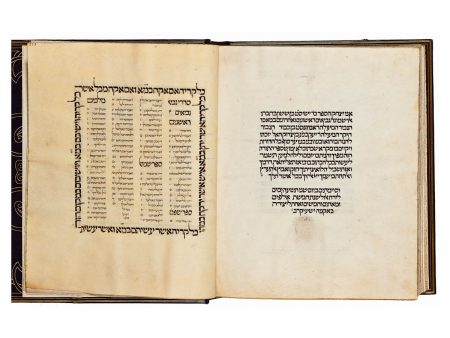Hebrew Bible
In the eighteenth century, this Hebrew Bible with Masorah Magna and Parva was housed in the library of the Convent of the Discalced Carmelites of S. Paolo in Florence. After that library was sacked by Napoleonic forces, the manuscript may have been
in the Vatican Library for a short while; the only source for this information is an English auction catalogue of 1827 in which the manuscript appeared. It remained in England until it was acquired from the library of the bibliophile Beriah Botfield for the Braginsky Collection.
Although the manuscript was bound into four vo umes in England during the nineteenth century, the original consisted of two parts, each with its own colophon. The first part comprised the Pentateuch and the Hagiographa, while the second contained all the books of the Prophets. At the end of the original second volume, now the fourth volume (page 73), the scribe and vocalizer Isaac ben Ishai Sason stated that he finished copying the manuscript in 1491 in Ocaña, in Castile. At the end of the original first vol- ume, now the second volume, he wrote a colophon with another year of completion, 1494 (page 71). This appears within a detailed interlaced frame with pen flourishes along the outer and part of the inner borders. He finished this part, however, in Evora, in the Kingdom of Portugal. With his fellow Jews Isaac had been expelled from Spain in 1492 and forced to flee to Portugal, where he copied the Pentateuch and Hagiographa. In the latter colophon the scribe even indicated that it had been two years since the expulsion from Castile. Whether he did indeed copy the manuscript in this unusual order, first Prophets, then Pentateuch and Hagiographa, or whether an original first part got lost as a result of the expulsion, necessitating its replacement, cannot be known.
According to tradition, the text of the Song of Moses, (Ha’azinu) Deuteronomy 32:1–43 (page 74), is arranged as two columns composed of bricks placed one above the other. The vertical arrangement of the Masorah Magna on either side of the single column of text of the end of the chapter that precedes the song, displays Isaac ben Ishai Sason’s keen artistic sensibility. [ e s ]
selected literature Christie’s London 2002, lot 5.
Hebrew Bible
Ocaña (Spain), 1491 and Evora (Portugal) 1494, copied and vocalized by Isaac ben Ishai Sason
Parchment, four volumes, volume 1: 270 leaves, volume 2: 182 leaves, volume 3: 184 leaves, volume 4: 193 leaves, 322 × 263 mm (12.7 × 10.4 in.), 19th-century gold-tooled purple leather binding
Braginsky Collection 243
